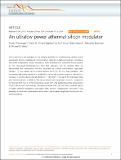An ultralow power athermal silicon modulator
Author(s)
Timurdogan, Erman; Sorace-Agaskar, Cheryl M.; Sun, Jie; Shah Hosseini, Ehsan; Biberman, Aleksandr; Watts, Michael; ... Show more Show less
DownloadWatts_An ultralow.pdf (1.423Mb)
PUBLISHER_CC
Publisher with Creative Commons License
Creative Commons Attribution
Terms of use
Metadata
Show full item recordAbstract
Silicon photonics has emerged as the leading candidate for implementing ultralow power wavelength–division–multiplexed communication networks in high-performance computers, yet current components (lasers, modulators, filters and detectors) consume too much power for the high-speed femtojoule-class links that ultimately will be required. Here we demonstrate and characterize the first modulator to achieve simultaneous high-speed (25 Gb s[superscript −1]), low-voltage (0.5 V[subscript PP]) and efficient 0.9 fJ per bit error-free operation. This low-energy high-speed operation is enabled by a record electro-optic response, obtained in a vertical p–n junction device that at 250 pm V[superscript −1] (30 GHz V[superscript −1]) is up to 10 times larger than prior demonstrations. In addition, this record electro-optic response is used to compensate for thermal drift over a 7.5 °C temperature range with little additional energy consumption (0.24 fJ per bit for a total energy consumption below 1.03 J per bit). The combined results of highly efficient modulation and electro-optic thermal compensation represent a new paradigm in modulator development and a major step towards single-digit femtojoule-class communications.
Date issued
2014-06Department
Massachusetts Institute of Technology. Department of Electrical Engineering and Computer Science; Massachusetts Institute of Technology. Research Laboratory of ElectronicsJournal
Nature Communications
Publisher
Nature Publishing Group
Citation
Timurdogan, Erman, Cheryl M. Sorace-Agaskar, Jie Sun, Ehsan Shah Hosseini, Aleksandr Biberman, and Michael R. Watts. “An Ultralow Power Athermal Silicon Modulator.” Nature Communications 5 (June 11, 2014).
Version: Final published version
ISSN
2041-1723